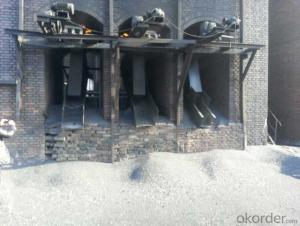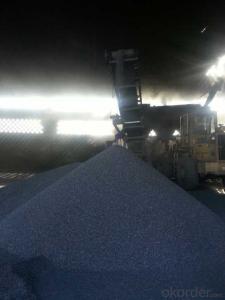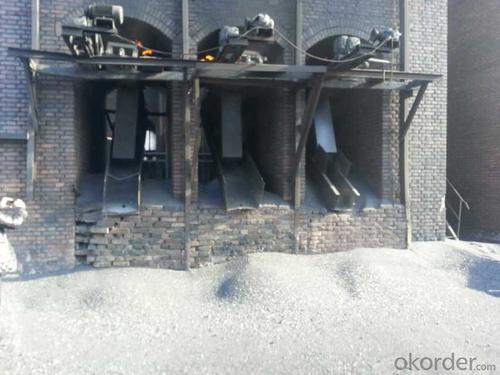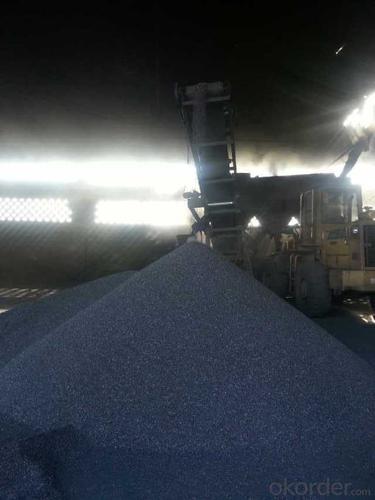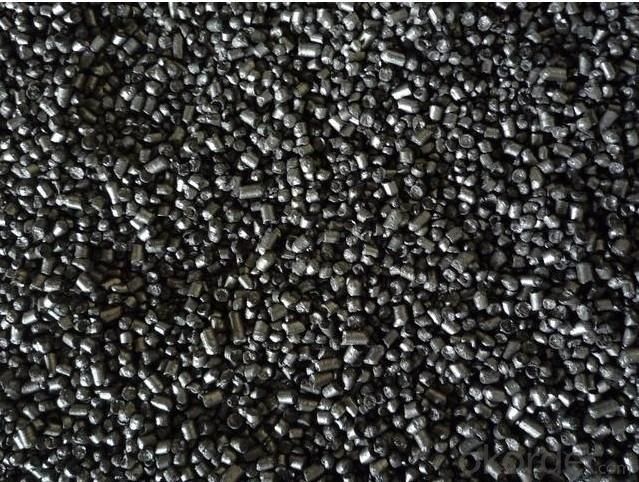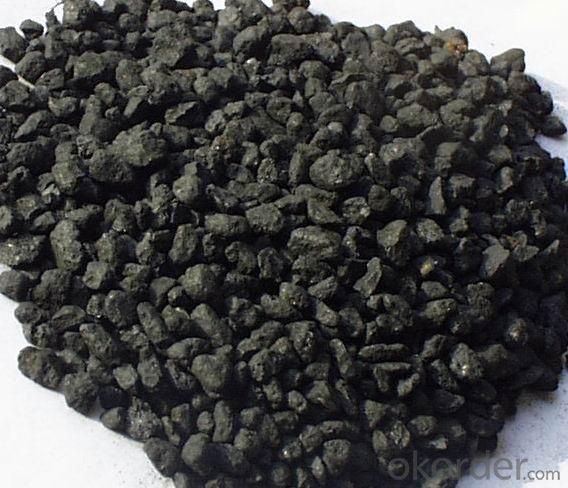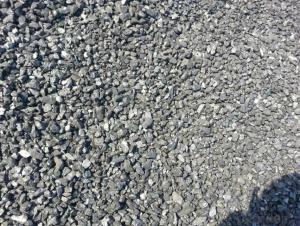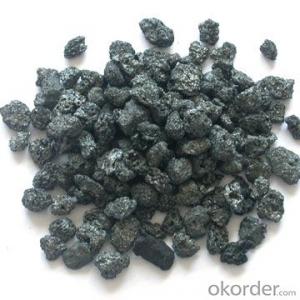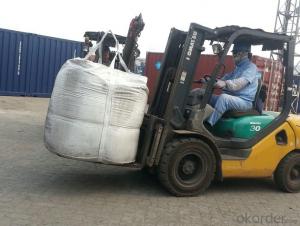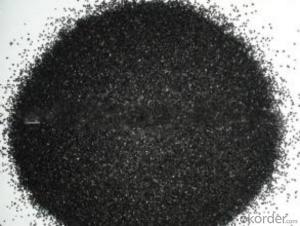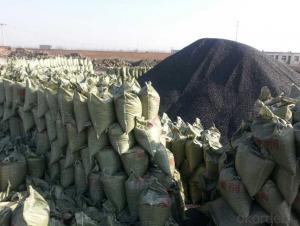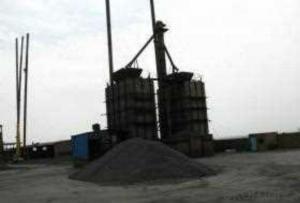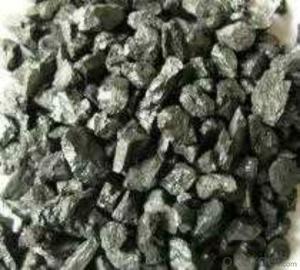Calcined Aanthracite Used as Charge Coke FC82-90%
- Loading Port:
- Tianjin
- Payment Terms:
- TT OR LC
- Min Order Qty:
- 20 m.t.
- Supply Capability:
- 5000 m.t./month
OKorder Service Pledge
OKorder Financial Service
You Might Also Like
Packaging & Delivery
25kgs/50kgs/1ton per bag or as buyer's request
Specifications
Calcined Anthracite
Fixed carbon: 90%-95%
S: 0.5% max
Size: 0-3. 3-5.3-15 or as request
It used the high quality anthracite as raw materials through high temperature calcined at over 2000 by the DC electric calciner with results in eliminating the moisture and volatile matter from anthracite efficiently, improving the density and the electric conductivity and strengthening the mechanical strength and anti-oxidation. It has good characteristics with low ash, low resistvity, low sulphur, high carbon and high density. It is the best material for high quality carbon products.
Advantage and competitive of caclined anthracite:
1. strong supply capability
2. fast transportation
3. lower and reasonable price for your reference
4.low sulphur, low ash
5.fixed carbon:95% -90%
6..sulphur:lower than 0.3%
General Specification of Calcined Anthracite:
| FC | 90 | 88 | 85 | 83 | 82 |
| ASH | 8.5 | 10 | 12 | 14 | 15 |
| V.M. | 1.5 | 2 | 3 | 3 | 3 |
| S | 0.35 | 0.5 | 0.5 | 0.5 | 0.5 |
| MOISTURE | 0.5 | 1 | 1 | 1 | 1 |
Pictures

Advantage:
1.High quality and competitive price.
2.Timely delivery.
3.If any item you like. Please contact us.
Your sincere inquiries are typically answered within 24 hours.
- Q: How is carbon used in the production of filters?
- Carbon is used in the production of filters due to its highly porous nature and ability to adsorb impurities. It acts as a powerful adsorbent, attracting and trapping contaminants such as chemicals, odors, and particles from air or water. This makes carbon an excellent material for removing impurities and improving the quality of filtered products.
- Q: What are the consequences of increased carbon emissions on economic stability?
- Economic stability is significantly impacted by the increase in carbon emissions. Climate change worsens as a result, resulting in more frequent and severe natural disasters like hurricanes, floods, and wildfires. These events cause immense economic damage, including infrastructure destruction, property loss, and supply chain disruption. Moreover, the economic implications of climate change, driven by the rise in carbon emissions, are long-term. Coastal cities and industries are threatened by rising sea levels, leading to potential population displacement and valuable asset loss. Agricultural productivity is affected by extreme heatwaves and droughts, impacting food security and causing price increases. These climate-related disruptions can destabilize economies, especially in vulnerable regions highly dependent on agriculture or tourism. Furthermore, substantial financial investments are required for climate change mitigation and adaptation efforts, such as transitioning to cleaner energy sources and implementing climate policies. This strains government budgets and diverts resources from other socio-economic priorities, potentially resulting in reduced funding for education, healthcare, and infrastructure development. Additionally, increased carbon emissions have economic consequences beyond immediate climate-related impacts. The reliance on fossil fuels as the primary energy source contributes to volatile oil prices, which can disrupt global markets and affect economic stability. As the world moves towards a low-carbon economy, industries heavily reliant on fossil fuels may face significant challenges, leading to job losses and economic upheaval. To summarize, the increase in carbon emissions has extensive effects on economic stability. Climate change causes more frequent and severe natural disasters, resulting in significant economic damage. Responding to climate change through mitigation and adaptation efforts strains government budgets and diverts resources from other critical sectors. Moreover, the reliance on fossil fuels poses long-term risks to industries tied to these resources. It is essential to address carbon emissions to safeguard economic stability and foster sustainable growth.
- Q: Where do I buy DNF premium advanced carbon?
- Before in the mall to buy, now advanced has been officially cancelled only in the network, the old machine and rock strengthening reinforcement, carbon furnace has been canceled, now can only rely on colorless strengthening, but to strengthen and improve the success rate of the previous 10 carbon furnace rock will burst, now with a colorless hundred won't burst. So please accept, quack quack!
- Q: What are the impacts of carbon emissions on human respiratory diseases?
- Carbon emissions have significant impacts on human respiratory diseases. The release of carbon dioxide and other greenhouse gases from various sources, such as burning fossil fuels and deforestation, contributes to air pollution. This pollution can lead to the exacerbation of respiratory conditions such as asthma, chronic obstructive pulmonary disease (COPD), and respiratory infections. Additionally, exposure to particulate matter and toxic chemicals emitted from carbon-based industries can increase the risk of developing respiratory diseases and worsen existing conditions. Overall, reducing carbon emissions is crucial to mitigate the adverse effects on human respiratory health.
- Q: How does carbon impact the acidity of rainfall?
- Carbon does impact the acidity of rainfall through a process known as acid rain. When carbon dioxide (CO2) is released into the atmosphere, it combines with water (H2O) and forms carbonic acid (H2CO3). This reaction occurs naturally, but human activities such as burning fossil fuels and industrial processes have significantly increased the amount of carbon dioxide in the atmosphere. When carbonic acid is formed, it can react with other compounds in the air, such as sulfur dioxide (SO2) and nitrogen oxides (NOx), to form even stronger acids like sulfuric acid (H2SO4) and nitric acid (HNO3). These acids then dissolve in rainwater, forming acid rain. The presence of carbon in the atmosphere contributes to the overall acidity of rainfall. Acid rain has detrimental effects on the environment, ecosystems, and human health. It can damage forests, lakes, and rivers, leading to the depletion of fish populations and the destruction of habitats. Acid rain can also erode buildings and monuments, corrode metals, and harm crops. The impacts of carbon on the acidity of rainfall highlight the importance of reducing carbon emissions and addressing climate change. By transitioning to cleaner energy sources, implementing sustainable practices, and reducing our carbon footprint, we can help mitigate the acidity of rainfall and minimize the negative consequences associated with acid rain.
- Q: How much is a ton of carbon fiber? How much difference is made between domestic and imported?
- Industrial grade carbon fiber, ranging in price from 160 thousand to 290 thousand.
- Q: Which carbon content is larger, steel or pig iron?
- Iron and steel is distinguished by carbon: carbon content below 2.11% for carbon steel, according to can be divided into carbon steel low carbon steel (WC = 0.25%), carbon steel (WC0.25% - 0.6%) and high carbon steel (WC>0.6%);
- Q: How can carbon capture and storage help reduce greenhouse gas emissions?
- Carbon capture and storage (CCS) can help reduce greenhouse gas emissions by capturing carbon dioxide (CO2) emissions from power plants and industrial facilities before they are released into the atmosphere. This technology allows for the separation and capture of CO2, which can then be transported and stored underground in geological formations. By preventing these emissions from entering the atmosphere, CCS helps to mitigate climate change and reduce the overall concentration of greenhouse gases.
- Q: How does carbon impact the global water cycle?
- Carbon plays a significant role in the global water cycle as it influences the temperature and precipitation patterns. Increased levels of carbon dioxide in the atmosphere, primarily due to human activities, contribute to global warming, leading to rising temperatures. These higher temperatures enhance evaporation rates, causing more water to evaporate from oceans, lakes, and other water bodies. This increased evaporation intensifies the water cycle, resulting in more frequent and intense rainfall events. Conversely, carbon emissions also contribute to climate change, which can lead to droughts in certain regions, disrupting the global water cycle and exacerbating water scarcity issues. Overall, carbon impacts the global water cycle by influencing temperature, precipitation patterns, and the occurrence of extreme weather events.
- Q: What is carbon black used for?
- Carbon black is a versatile substance that finds applications in various industries. Primarily, it is used as a pigment and reinforcing filler in the production of rubber products, such as tires, hoses, and belts. The addition of carbon black enhances the strength, durability, and resistance to abrasion of rubber materials. Additionally, carbon black is used as a coloring agent in inks, paints, and coatings due to its excellent light-absorbing properties. It provides intense black color and improves the UV resistance of these products. Moreover, carbon black is utilized in the production of plastics, where it acts as a filler to enhance the mechanical properties of plastic components and reduce their cost. In the energy sector, carbon black is employed as a conductive additive in batteries and fuel cells. Its high electrical conductivity enhances the performance of these energy storage devices. Carbon black is also used in the manufacture of electrodes for supercapacitors, where its large surface area enables efficient energy storage. Furthermore, carbon black has applications in the construction industry as a reinforcing agent in concrete and asphalt. It enhances the strength and durability of these materials, making them more resistant to cracking and weathering. In summary, carbon black is widely used in the production of rubber, plastics, inks, paints, coatings, batteries, fuel cells, supercapacitors, and construction materials. Its properties as a pigment, reinforcing filler, coloring agent, and conductive additive make it a valuable material in numerous industrial applications.
Send your message to us
Calcined Aanthracite Used as Charge Coke FC82-90%
- Loading Port:
- Tianjin
- Payment Terms:
- TT OR LC
- Min Order Qty:
- 20 m.t.
- Supply Capability:
- 5000 m.t./month
OKorder Service Pledge
OKorder Financial Service
Similar products
Hot products
Hot Searches
